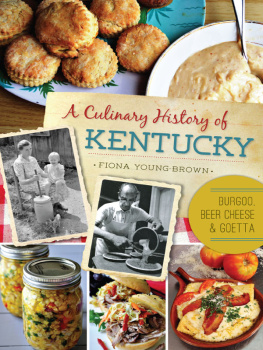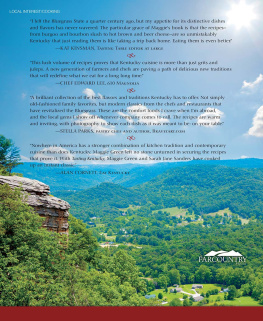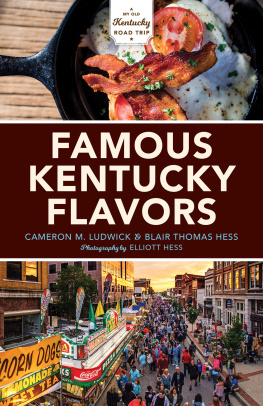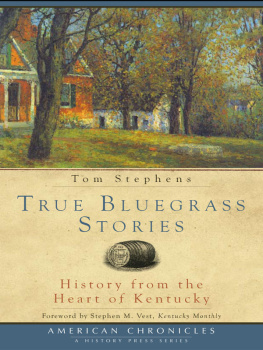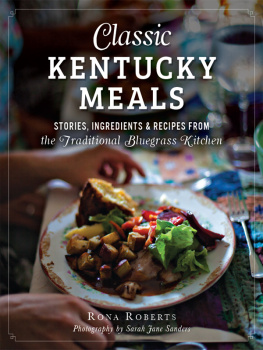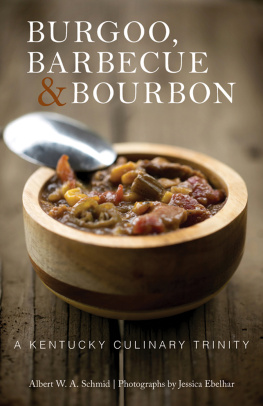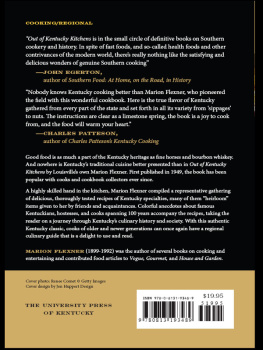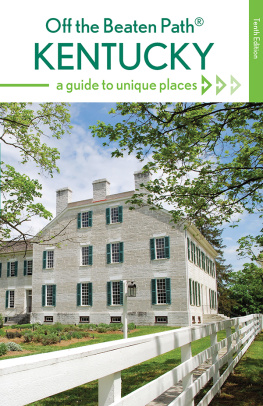

Published by American Palate
A Division of The History Press
Charleston, SC 29403
www.historypress.net
Copyright 2014 by Fiona Young-Brown
All rights reserved
Cover image of Walter Kern pouring a Derby Pie courtesy of Kerns Kitchen.
Images courtesy of the author unless otherwise noted.
First published 2014
e-book edition 2014
ISBN 978.1.62584.747.8
Library of Congress CIP data applied for.
print edition ISBN 978.1.62619.263.8
Notice: The information in this book is true and complete to the best of our knowledge. It is offered without guarantee on the part of the author or The History Press. The author and The History Press disclaim all liability in connection with the use of this book.
All rights reserved. No part of this book may be reproduced or transmitted in any form whatsoever without prior written permission from the publisher except in the case of brief quotations embodied in critical articles and reviews.
CONTENTS
ACKNOWLEDGEMENTS
As with any book project, there are many more people involved than I will probably remember to thank. However, I will do my best to express my gratitude to all those who have supported and helped me, both directly and indirectly.
First, I must thank my fellow Kentucky food bloggers, many of whom offered ideas, resources and suggestions. In particular, thanks to Maureen C. Berry for sharing her wonderful photographs, Rona Roberts for her knowledge of sorghum, Joyce Pinson for her knowledge of eastern Kentucky foodways and Michelle Turner for her sharing of custard recipes.
Thanks to those who helped me a few years back when I was researching a piece about the history of beer cheese for Culture magazineMark Sohn, Ronnie Lundy, John T. Edge and Sarah Fritschner. Little did I know at the time that it would feed my desire to learn more to the point that I would end up working on this book.
Many local restaurants and businesses helped by showing me their archives or facilities, sharing stories and more. The folks at Ale-8-One, Buffalo Trace, Old Hickory Bar-B-Q, Scott Hams, Smokey Pig, Kentucky State University and the Brown Hotel have all been very accommodating. Particular thanks go to Miss Dixie Huffman for her wonderful hospitality at Shaker Village in Pleasant Hill.
Several friends deserve special mention. Julie Quinn Blyth, Amanda Hervey and Neil Chethikthank you all. Thanks to my husband Nics family for sharing stories and recipes.
And lastly, thanks to Nic for offering advice and for putting up with me when I reach those last few weeks of pulling my hair out as I wonder if I will meet my deadline, as well as for being willing to try whatever dish I put in front of him.
INTRODUCTION
I experienced my first true taste of Kentucky in the summer of 1998 in the small town of Barbourville, where I was meeting my future in-laws. Mashed potatoes and gravy, ham, fried chicken, corn, deviled eggs, corn bread and freshly baked rolls were piled high on plates, accompanied by the green beans that had been furiously hissing in the pressure cooker. As my plate emptied, I was urged to help myself to more, but I dared not, having already spied the several types of pie that would serve as a more than ample dessert.
In the years since then, I have eaten many similar meals, and my appreciation for what appeared at first to be a very simple meal has grown immensely. The vegetables were all grown and harvested on the family farm, with the remainder baked in the ever-busy kitchen, using recipes that have been passed down through the generations. Much of the preparation has changed little since Rebecca Boone and the early pioneers learned to live on what the land provided. And provide it did. From the forests and mountains of Appalachia in the east to the rivers and pastures of the west, Kentucky is a natural cornucopia of deliciousness, offering fruits, vegetables, fish and fowl.
But it took me time to appreciate its rich abundance and simplicity. During my first weeks in the state, I happened to tune in to a radio interview with a few local farmers. They were discussing the harvest of peppers and zucchini blossoms. What should one do with these gems, asked the interviewer? Batter and fry them of course, came the reply. My heart sank, as it seemed that once again, the stereotype of Kentuckyand perhaps most southernfood as anything that can be battered and fried had reared its ugly head. Mention the word Kentucky, and no matter where you are in the world, people think of fried chicken. Greasy, fast-food chicken. In truth, Kentucky food is much more than that, and the fried chickenproper fried chickenis moist and flavorful, prepared with a skill that no fast-food restaurant can replicate.
My husband likes to tell me that food is how Kentuckians show their love. He may well be right, for there is an undeniable social value in the sharing of a meal here in the commonwealth. I defy you to visit any part of the state and not be offered, at the very least, a glass of tea, some fresh biscuits or a piece of chess pie. Holidays and reunions are centered on the intersection of food and family, and even in this age of convenience foods and TV dinners, mealtimes in much of Kentucky are still a vital time of coming together. As noted historian Thomas D. Clark wrote, Eating dinner in Kentucky is more than a physiological refueling of the human body; it is a joyous social ritual.
So what is Kentucky food? (Cuisine seems far too pretentious a term for something so richly based in the regions fertile ground.) To quote Marion Flexner, Kentucky cooking is a unique blend of many old-world cultures seasoned with native ingenuity, a cross section of American cookery at its best. Kentucky cooking is a collective memory of every pioneer who ever crossed the Cumberland Gap, every immigrant who settled here and every native who lived here before that. It is simple yet complex in its origins. It is more than a meal on a plate. It is community. It is hospitality. It is history.
Note: It will be somewhat inevitable that some readers will not find a particular Kentucky favorite mentioned within these pages. While I have attempted to paint a broad picture of Kentucky foodways, this book is not intended to be a complete survey of the states eating habits and recipes. Rather, it is a collection of historical tales and trivia about where some of our dishes come from. In looking at the influences behind our food, I hope to also show how the generations of settlers and immigrants from various cultures have taken those dishes and adapted them to become something that is uniquely Kentucky.
PART I
KENTUCKY BEGINNINGS
SETTLING KENTUCKY
In 1750, Dr. Thomas Walker discovered the Cumberland Gap, a passage through the Appalachian Mountains from Virginia. A replica of the cabin he constructed can be seen at the Dr. Thomas Walker State Historic Site in Barbourville. A small fort, built in 1769, was soon abandoned, but six years later, Daniel Boone led a group of thirty loggers along the trail, often termed the Wilderness Road. Hired by the Transylvania Company, he and his companions would widen the path for the thousands of men, women and wagons that would eventually cross; some estimates claim that as many as 300,000 had crossed the Cumberland Gap by 1810. Unlike the first settlers in Jamestown and New England, who were not skilled as huntsmen and fishermen and therefore frequently starved despite the plethora of food sources, these pioneers were of much more rugged and hardy stock. Some would continue farther west, beyond the Mississippi, but most would settle and tame the wild frontier that was to become Kentucky. It would be all too easy to talk about Kentucky food as something that developed from that point on. To do so, however, would be to ignore one of the mainor indeed
Next page
